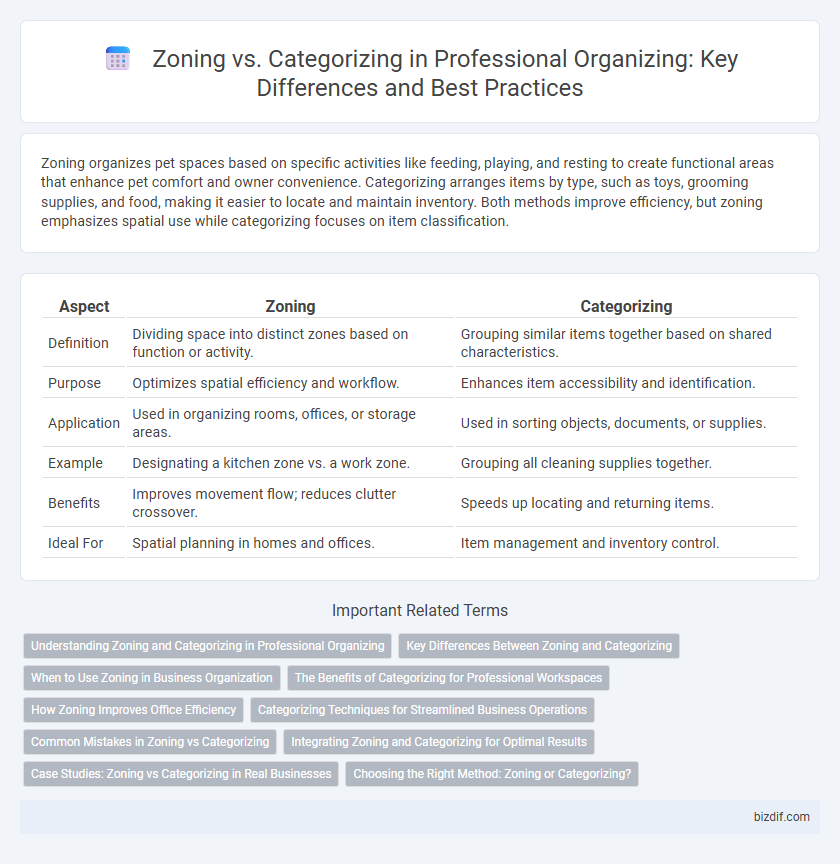Zoning organizes pet spaces based on specific activities like feeding, playing, and resting to create functional areas that enhance pet comfort and owner convenience. Categorizing arranges items by type, such as toys, grooming supplies, and food, making it easier to locate and maintain inventory. Both methods improve efficiency, but zoning emphasizes spatial use while categorizing focuses on item classification.
Table of Comparison
| Aspect | Zoning | Categorizing |
|---|---|---|
| Definition | Dividing space into distinct zones based on function or activity. | Grouping similar items together based on shared characteristics. |
| Purpose | Optimizes spatial efficiency and workflow. | Enhances item accessibility and identification. |
| Application | Used in organizing rooms, offices, or storage areas. | Used in sorting objects, documents, or supplies. |
| Example | Designating a kitchen zone vs. a work zone. | Grouping all cleaning supplies together. |
| Benefits | Improves movement flow; reduces clutter crossover. | Speeds up locating and returning items. |
| Ideal For | Spatial planning in homes and offices. | Item management and inventory control. |
Understanding Zoning and Categorizing in Professional Organizing
Zoning in professional organizing involves dividing a space into functional areas based on activity, such as creating a work zone, relaxation zone, and storage zone to enhance efficiency and flow. Categorizing focuses on grouping similar items together, like sorting belongings into categories such as books, papers, and office supplies for easier access and maintenance. Both zoning and categorizing optimize organization by aligning spatial layout with item grouping, improving productivity and clarity within any environment.
Key Differences Between Zoning and Categorizing
Zoning involves dividing a space into specific areas based on function or activity, such as creating separate zones for work, relaxation, and storage, which enhances spatial efficiency. Categorizing focuses on grouping similar items together, like organizing books by genre or clothes by type, to streamline access and retrieval. The key difference lies in zoning structuring the physical environment, while categorizing organizes the contents within those zones for optimized order and usability.
When to Use Zoning in Business Organization
Zoning is essential in business organization when defining clear physical or digital areas dedicated to specific functions, such as customer service, inventory storage, or project management. It enhances workflow efficiency by minimizing overlap and confusion, enabling employees to focus on specialized tasks within designated spaces. Using zoning is particularly beneficial in environments requiring strict adherence to safety protocols or regulatory compliance, as it ensures organized segregation of activities.
The Benefits of Categorizing for Professional Workspaces
Categorizing in professional workspaces enhances efficiency by grouping similar items and tasks, streamlining retrieval and reducing time spent searching. It supports task-specific organization, which improves workflow and productivity by keeping essential tools and documents accessible and logically arranged. This method also promotes a clutter-free environment, fostering focus and reducing stress for professionals.
How Zoning Improves Office Efficiency
Zoning enhances office efficiency by designating specific areas for distinct tasks, which reduces clutter and minimizes time spent searching for materials. This method streamlines workflow by aligning related resources and equipment within close proximity, encouraging focused productivity. Implementing zoning creates clear physical boundaries that support task-oriented behavior and improve overall organizational coherence in the workspace.
Categorizing Techniques for Streamlined Business Operations
Categorizing techniques in professional organizing involve grouping items based on shared attributes such as function, frequency of use, or project relevance, which enhances retrieval efficiency and reduces operational downtime. Implementing clear labeling systems and digital inventory tools further refines categorization, ensuring quick identification and accessibility of resources critical for business workflows. This strategic approach to categorizing supports consistency across teams and optimizes space utilization, driving streamlined business operations.
Common Mistakes in Zoning vs Categorizing
Common mistakes in zoning versus categorizing include confusing spatial division with item classification, leading to inefficient organization. Many professionals improperly blend zoning--allocating specific areas for activities--with categorizing, which groups items by type or function, resulting in cluttered or disorganized spaces. Misapplying these concepts often causes reduced accessibility and difficulty maintaining order in organized environments.
Integrating Zoning and Categorizing for Optimal Results
Integrating zoning and categorizing enhances professional organizing by combining spatial planning with item classification to maximize efficiency. Zoning defines specific areas for particular functions within a space, while categorizing groups similar items, ensuring quick access and streamlined organization. This synergy reduces clutter and improves workflow, leading to optimized, sustainable living or work environments.
Case Studies: Zoning vs Categorizing in Real Businesses
Case studies in professional organizing reveal that zoning enhances workflow efficiency by grouping items based on physical space and function, exemplified by manufacturing plants optimizing assembly line areas. Categorizing, used by retail businesses like grocery stores, focuses on sorting products by type or category, improving inventory management and customer navigation. Combining zoning and categorizing strategies in office environments has shown to boost productivity by creating designated areas for specific tasks while organizing materials within those zones by category.
Choosing the Right Method: Zoning or Categorizing?
Choosing the right organizing method depends on your space and lifestyle needs; zoning divides areas based on activities to streamline daily routines, while categorizing groups items by type for easy access and inventory management. Zoning is ideal for dynamic spaces like kitchens or home offices where function dictates placement, whereas categorizing works best in closets or storage rooms where item type governs organization. Assess your habits and spatial constraints to decide if function-driven zoning or item-centric categorizing enhances efficiency and maintains order in your environment.
Zoning vs Categorizing Infographic

 bizdif.com
bizdif.com